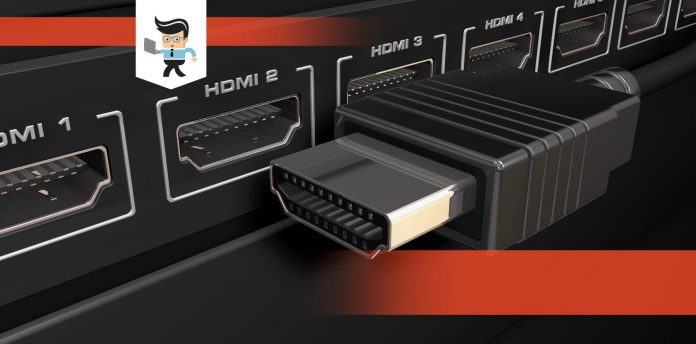A graphics card with 2 HDMI ports will provide the best capability to use multiple displays with your computer.

In the age of multitasking, having more than one monitor set up with your computer will allow you to have more in the field of view at any given time.
Some monitors will take a DVI or VGA cable, but most modern monitors will take HDMI and Display Port. If you already have two monitors with an HDMI connection and need to find a dual monitor HDMI video card that will support both of them, read on to find the best dual HDMI GPU for you.
Contents
Best Dual HDMI graphics card
The GTX 1080 Ti is absolutely the best graphics card you can get that offers multiple HDMI ports. It offers the most processing cores, the most memory, and the fastest clock speed. If money no object and you want the best performance, it is the best option. If you play less demanding games or won’t be gaming at all, you should look for a cheaper alternative.
AMD has recently reclaimed some of the market share of both central processing units and graphics processors, so if you have an AMD setup and also want to run a GPU with 2 HDMI ports, there are some midrange solutions for you as well.
Dual HDMI Graphics Card Comparison
| GTX 1080 Ti | Radeon RX 5700 XT | Radeon RX Vega 64 | GTX 1650 | GTX 1050 | |
| CUDA Cores | 3584 | N/A | N/A | 896 | 640 |
| Stream Processors | N/A | 2560 | 4096 | N/A | N/A |
| ROPs | 88 | 64 | 64 | 32 | 32 |
| Base Clock | 1480 MHz | 1605 MHz | 1276 MHz | 1485 MHz | 1354 MHz |
| Boost Clock | 1582 MHz | 1755 MHz | 1560 MHz | 1665 MHz | 1455 MHz |
| Memory Clock | 11 Gbps GDDR5 | 14 Gbps GDDR6 | 1.89 Gbps HBM 2 | 8 Gbps GDDR5 | 7 Gbps GDDR5 |
| VRAM | 11 GB | 8 GB | 8 GB | 4GB | 2 GB |
| Single Precision Perf. | 10 TFLOPS | 9.75 TFLOPS | 11.2 TFLOPS | 2.6 TFLOPS | 1.9 TFLOPS |
| TDP | 250 W | 225 W | 295 W | 75 W | 75 W |
| GPU | GP102 | Navi 10 | Vega 10 | TU117 | GP107 |
| Architecture | Pascal | RDNA | Vega | Turing | Pascal |
• GeForce GTX 1080 Ti
Other than the Titan, the GTX 1080 Ti is the most powerful graphics card on the market. Beyond being one of the most powerful graphics cards for consumer use, the GTX 1080 Ti is a star of NVIDIA’s Pascal architecture.
The GTX 1080 Ti excels in performance, running at a base 1480MHz frequency and 1582MHz when boosted. It boasts 3584 CUDA cores and 88 ROPs and the 1080 Ti’s 11GB VRAM is blazing fast 11Gbps.
Design
The angular silver body of the GTX 1080 Ti is in line with the rest of the GTX products from NVIDIA. Externally, the original GeForce GTX 1080 and NVIDIA’s latest Ti card are substantially similar.
If you are looking for a graphics card with 2 HDMI outputs then make sure you get the version of the 1080 Ti that offers at least two HDMI ports like the Gigabyte AORUS, as many come with three Display Ports and only one HDMI. The AORUS is a multiple HDMI video card, with 3 HDMI ports, 3 Display Ports, and 1 DVI Port for any peripherals you need to attach.
Performance
4K gaming at 60 fps is one of the ultimate goals of PC gaming with the processors and graphics cards available in the last few years, and the 1080 Ti comes pretty close. Though, the ability to render 4K resolution at 60 fps depends heavily on how graphically intense the games are that you are trying to play.
With regard to the pure-performance testing 3DMark: FireStrike Ultra, the GTX 1080 Ti blows past its predecessors by a gap of 2,000 to 4,000 points across all categories. Even more impressive is that this GeForce is ahead of the Titan too, without any overclocking.
If money is no object and you want the best performance available, it is the best option. It is particularly good for 4K gaming as lower graphics cards cannot handle rendering the graphics settings of modern games and provide a high framerate at 4K resolutions. If you play less demanding games or won’t be gaming at all, you should look for a cheaper multiple HDMI video card .
• Radeon 5700 XT
If you thought you couldn’t find graphics cards with 2 HDMI ports because you have an AMD machine, think again. The Gigabyte AORUS Radeon RX 5700 XT offers 3 HDMI ports and 3 Display Ports to run any peripherals you need.
The launch of the RX 5700 is significant for both the gamers that use Radeon cards and the AMD market share. This is the first series of high-volume consumer graphics cards using a 7nm process. This drives up performance at the same time as driving cost down during a period when video card cost has been slow to improve.
For AMD, this launch gets the first cards with their RDNA architecture process out to its first users, while at the same time reminding the consumers why they are competitive in the midrange market. The line of RX 5700 series cards aren’t flagship-level, but they are as important as any flagship release due to the new technology within.
Design
The Radeon RX 5700 XT overall has a carbon gray appearance and features a central fan which spins in the opposite direction to the other two, preventing turbulent air flow between the fans and improving the cooling of the design.
The specific Radeon RX 5700 XT graphics card with 2 HDMI outputs reviewed here is the Gigabyte AORUS, which also offers customizable RGB lighting along the top and bottom of the card which will synchronize with any other AORUS products you own.
Performance
AMD has an edge over NVIDIA’s manufacturing process by using TSMC 7nm versus the 16nm architecture that NVIDIA uses, but the Radeon 5700 XT does not have the ray tracing or variable rate shading features of the GTX cards. AMD and NVIDIA’s cards are not equal in the features they offer which that will play a big part in their value.
Ultimately, the 5700 XT is not a card that sweeps in and overwhelms its predecessor in terms of performance. Like the RTX 20 series, the RX 5700 is a more gradual change in both pricing and performance.
Developing high-performance GPU’s is expensive, and AMD sunk a lot of research into their 7 nm silicon. For the moment, the RX 5700 series is, for all intents and purposes, part of the same generation of GPUs as the RTX 20/GTX 16 series with all associated pros and cons.
• Radeon Vega 64
The Vega architecture, represented here by the Vega 10, is focused on delivering faster cards with higher clock speeds. The compute units of the Vega 10 have been completely redesigned for optimization, reducing the amount of the physical wiring inside them.
The Vega architecture supports both standard DirectX-based rendering and shader support for newer rendering through the use of a new geometry engine. The revised pixel engine is redesigned to handle the high-resolution and high refresh rate displays used by modern gamers. AMD doubled the L2 cache available for the GPU to use and freed up the entire cache so that all the logic on the Vega chip can access it.
Design
The design aesthetic of the Vega 64 means it will not be out of place in a high end gaming rig with embellishments. It has a sculpted black casing with red stripes running at an angle at both the top and the bottom of the card with two fans that spin in opposite directions to counteract turbulent airflow and deliver the most efficient cooling to the GPU
Performance
Early marketing and buzz for the AMD RX Vega 64 promised that it was being designed to be a direct competitor to the GTX 1080.
When the Vega 64 price point dropped enough to make it competitive, almost a year after release, the GTX 1080 was the second-tier consumer GeForce card, which isn’t favorable for the AMD in comparison.
The Vega 64 holds its own and delivers performance that is just slightly shy of what the GTX 1080 can deliver. However, its performance and competitiveness drop when overclocked versions of NVIDIA’s GPUs enter the scene.
Yes, a factory-overclocked GTX 1080 will outclass a stock Vega 64, especially given the price premium of the 1080. But, an overclocked GTX 1070 can beat the Vega 64 as well, and that is harder to accept in terms of performance.
The AMD GPU struggles to compete with the high end 10 series cards from NVIDIA, released over a year later and still behind the times relative to the older silicon technology in the GeForce cards in many instances. AMD created a GPU with billions of additional transistors, with a significantly higher total platform power consumption, in order to compete with the GP104 GPU.
• GeForce GTX 1650 Mini ITX
The GeForce GTX 1650 is a budget-friendly, compact card based on the Turing architecture, offering 3 HDMI ports and 3 Display Ports. The GTX-16 series do not have RT Cores (Ray Tracing) or Tensor cores and use their original shader model.
The 16 series cards are meant to take their place in the gap below the RTX 20 series cards and succeed the GTX 10 series, which use the Pascal architecture.
Design
The 1650 Mini ITX is simplistic, stripped down to a single fan, offering compact space inside the computer case with stylistic angular gray accents against a black shell.
Performance
The 1650 Mini ITX also offers some of the lowest power consumption on the market, tied with the GeForce 1050 at only 75 W, but has faster memory processing than both the Vega 64 and the GeForce 1050, and a higher base clock than each of these competitors.
This is the least expensive of the graphics cards discussed here, and the older shader technology with the GTX 1050 and the Vega 64 occupying roughly the same price point, with the 5700 XT slightly higher.
• GeForce GTX 1050
On the low end of the performance scale sits the GTX 1050. This is the only low profile dual HDMI video card discussed in this post. While the GTX 1650 is perfunctorily short with only the space of one fan, the GTX 1050 is a slim card that does not take up a large amount of real estate in the computer case, but still occupies a dual-height PCI-E slot.
This card reasonably priced, offers 2 HDMI ports, and is small. However, it is an older card and you should not expect next-level performance from it.
Design
The GTX 1050 has a textured black case with a single fan to cool the chip and no other ornamentation. This is a budget graphics card without striping, lighting, or other additions to the aesthetics
Performance
The 1050 s ideal for competitive games such as CSGO, Fornite, etc. and depending on the rest of the setup of the computer, you can achieve framerates well over 60fps. This card will also run more demanding games but it is not designed for AAA gaming and you will likely have to turn the settings down.
Conclusion
If you can afford the NVIDIA GTX 1080 Ti, then it is absolutely the best dual HDMI graphics card you can buy.
If not, you are better off going with the less expensive GTX 1650, and if you have an AMD setup which requires you to use an AMD graphics card, the RX 5700 XT Radeon card will give you the performance you are looking for with multiple HDMI outputs and will allow you to use multiple displays with your video card.







